
A teaspoon (tsp.) is an item of cutlery. It is a small spoon that can be used to stir a cup of tea or coffee, or as a tool for measuring volume. The size of teaspoons ranges from about 2.5 to 7.3 mL. For cooking purposes and dosing of medicine, a teaspoonful is defined as 5 mL, and standard measuring spoons are used.
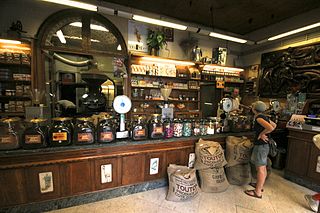
Italians are well known for their special attention to the preparation, the selection of the blends, and the use of accessories when creating many types of coffees. Many of the types of coffee preparation known today also have their roots here. The main coffee port in Italy is Trieste where there is also a lot of coffee processing industry. Italian coffee consumption, often espresso, is highest in the city of Trieste, with an average of 1500 cups of coffee per person per year. That is about twice as much as is usually drunk in Italy.

A teapot is a vessel used for steeping tea leaves or a herbal mix in boiling or near-boiling water, and for serving the resulting infusion which is called tea. It is one of the core components of teaware. Dry tea is available either in tea bags or as loose tea, in which case a tea infuser or tea strainer may be of some assistance, either to hold the leaves as they steep or to catch the leaves inside the teapot when the tea is poured. Teapots usually have an opening with a lid at their top, where the dry tea and hot water are added, a handle for holding by hand and a spout through which the tea is served. Some teapots have a strainer built-in on the inner edge of the spout. A small air hole in the lid is often created to stop the spout from dripping and splashing when tea is poured. In modern times, a thermally insulating cover called a tea cosy may be used to enhance the steeping process or to prevent the contents of the teapot from cooling too rapidly.

A mug is a type of cup typically used for drinking hot drinks, such as coffee, hot chocolate, or tea. Mugs usually have handles and hold a larger amount of fluid than other types of cups. Typically, a mug holds approximately 240–350 ml of liquid. A mug is a less formal style of drink container and is not usually used in formal place settings, where a teacup or coffee cup is preferred. Shaving mugs are used to assist in wet shaving.
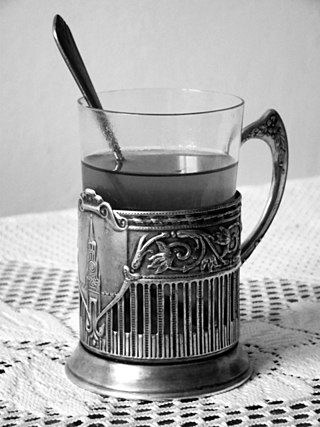
A zarf is a holder, usually of ornamental metal, for a coffee cup without a handle.

A demitasse, demi-tasse, or espresso cup is a small cup used to serve espresso. It may also refer to the coffee served in such a cup, though that usage had disappeared in France by the early 20th century.
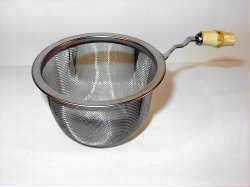
A tea strainer is a type of strainer that is placed over or in a teacup to catch loose tea leaves.

A saucer is a type of small dishware. While in the Middle Ages a saucer was used for serving condiments and sauces, currently the term is used to denote a small plate or shallow bowl that supports a cup – usually one used to serve coffee or tea.
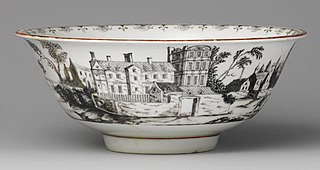
In Europe, a slop bowl, slop basin or waste bowl is one of the components of a traditional tea set. It was used to empty the cold tea and dregs in tea cups before refilling with hot tea, as there were often tea leaves in the bottom of the cups.

The Korean tea ceremony is a traditional form of tea ceremony practiced in Korea. Darye literally refers to "etiquette for tea" or "tea rite" and has been kept among Korean people for over a thousand years. The chief element of the Korean tea ceremony is the ease and naturalness of enjoying tea within an easy formal setting.

A coffee cup is a container, a cup, for serving coffee and coffee-based drinks. There are three major types: conventional cups used with saucers, mugs used without saucers, and disposable cups. Cups and mugs generally have a handle. Disposable paper cups used for take-out sometimes have fold-out handles, but are more often used with an insulating coffee cup sleeve.

A tea set or tea service is a collection of matching teaware and related utensils used in the preparation and serving of tea. The traditional components of a tea set may vary between societies and cultures.
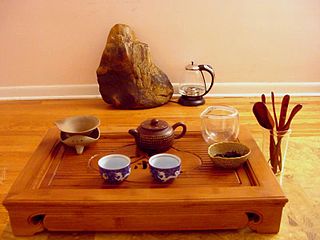
Gongfu tea or kung fu tea, literally "making tea with skill", is a traditional Chinese tea preparation method sometimes called a "tea ceremony". It is probably based on the tea preparation approaches originating in Fujian and the Chaoshan area of eastern Guangdong. The practice involves using smaller brewing vessels and a higher leaf-to-water ratio than in Western-style brewing. Today, the approach is used popularly by teashops carrying tea of Chinese or Taiwanese origin, and by aficionados and trained masters as a way to fully realize the taste of a tea selection, especially a finer one.

A gaiwan or zhong (盅) is a Chinese lidded bowl without a handle, used for the infusion of tea leaves and the consumption of tea. It was invented during the Ming dynasty. It consists of a bowl, a lid, and a saucer.

Tibetan cuisine includes the culinary traditions and practices of the Tibetan people in the Tibet region. The cuisine reflects the Tibetan landscape of mountains and plateaus and includes influences from neighbors. It is known for its use of noodles, goat, yak, mutton, dumplings, cheese, butter, yogurt, and soups. Vegetarianism has been debated by religious practitioners since the 11th century but is not prevalent due to the difficulty of growing vegetables, and cultural traditions promoting consumption of meat.

Yixing clay teapots, also called Zisha teapot, are made from Yixing clay. This traditional style commonly used to brew tea originated in China, dating back to the 15th century, and are made from clay produced near Yixing in the eastern Chinese province of Jiangsu.
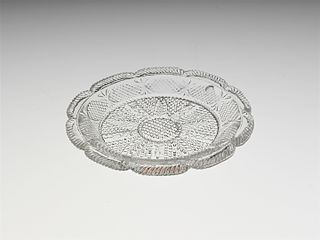
Cup plates are coasters that provide a place to rest a tea cup while leaving space for a light snack. Teacup plates originated in England in the early 1800s and went out of fashion in the second half of the 19th century, with a brief reappearance in the first third of the 20th century as bridge sets. The cup plates were in common use in the United States during the first half of the 19th century, and were a precursor of the very specialized dishes of Victorian era: ice cream sets, berry sets, lemonade sets, etc.

Since the 18th century, the United Kingdom has been one of the world's largest tea consumers, with an average annual per capita supply of 1.9 kilograms (4.2 lb). Originally an upper-class drink in Europe, tea gradually spread through all classes, eventually becoming a common drink. It is still considered an important part of the British identity and is a prominent feature of British culture and society.

A cup is an open-top container used to hold liquids for pouring or drinking. Although mainly used for drinking, it also can be used to store solids for pouring. Cups may be made of glass, metal, china, clay, wood, stone, bone, polystyrene, plastic, aluminium or other materials, and are usually fixed with stem, handles, or other adornments. Cups are used for quenching thirst across a wide range of cultures and social classes, and different styles of cups may be used for different liquids or in different situations. Cups of different styles may be used for different types of liquids or other foodstuffs, in different situations, or for decoration.
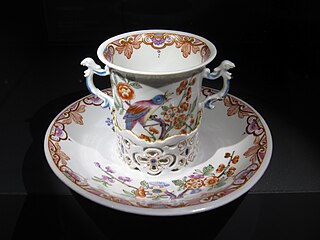
Trembleuse or tasse trembleuse also gobelet et soucoupe enfoncé, is a drinking cup and saucer with the saucer given a raised holding area in which the cup sits more securely than in the normal style. Often the well in the saucer is in openwork, as in the Vienna example illustrated. Then it is called a Mancerina.




















